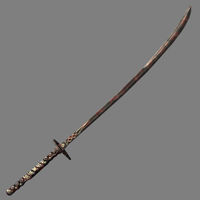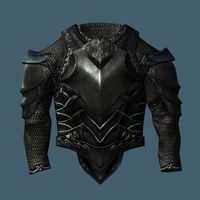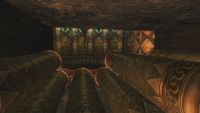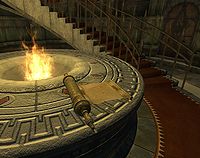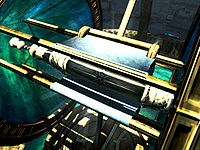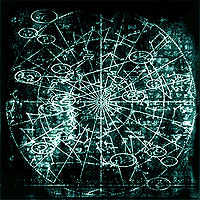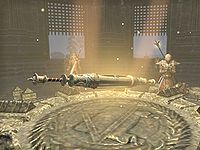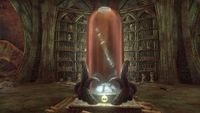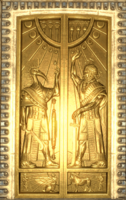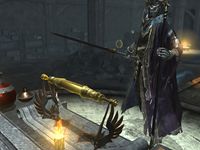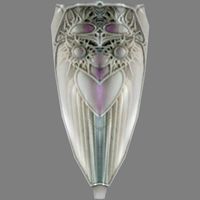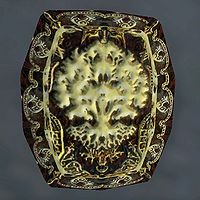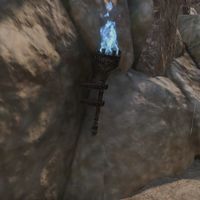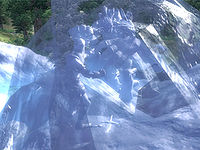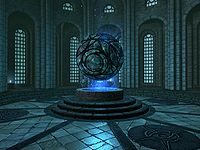Lore:Artifacts E
Ebony Blade[edit]
The Ebony Blade, also known as the Vampire or the Leech, is a Daedric artifact created by the Daedric Prince Mephala. It resembles an ebony katana, and is considered to be an artifact of great evil, having the ability to absorb the life essence of those that it strikes. Part of the damage inflicted flows into the wielder as raw power, draining the victim of their health and sometimes stamina. It has also been known to fortify the wielder's skill at using long blades, magically silence those that it strikes to prevent them from casting spells, and deceive victims. Khajiiti myths do not mention the blade by name, but instead refer to it as 'the killing word of the Spider' and 'the black edge of shadow'.
Ebony Mail[edit]
The Ebony Mail is a Daedric artifact created by the Daedric Prince Boethiah. In appearance it looks like an ebony suit of armor, or often simply a cuirass. It can either be medium or heavy in weight. The artifact grants its wearer resistance to fire and magical attacks, magical protection from physical blows, quieter movements and the ability to poison enemies who get too close. The artifact was created before recorded history by Boethiah, and it is Boethiah alone who determines who should possess the Mail and for how long a time.
Elder Scrolls[edit]
The Elder Scrolls (Kelle in the Dragon Language), also called the Aedric Prophecies, are scrolls of unknown origin which archive both past and future events.
The exact number of Scrolls in the world is unknowable. They "do not exist in countable form", and they may disappear and reappear from moment to moment and place to place.
Reading an Elder Scroll[edit]

Elder Scrolls contain writing in an unknown script and what seem to be star charts depicting Constellations. According to one scholar, for an individual with "no training in the history or knowledge of the Scrolls", there is nothing revelatory about them and there are no adverse side affects from reading them.
Without preparation, a Scroll will take the sight or sanity of a reader who understands it's importance. They will, however, get a glimpse of the Scroll's contents, which may include insight into the future, the past, or the nature of reality.
Due to the risks involved, the task of storing, cataloging and reading the Elder Scrolls has traditionally fallen on the Cult of the Ancestor Moth. The Cult had devised a method of reading them, known as the Ritual of the Ancestor Moth, that used the aid of the sacred Ancestor Moths themselves to dampen the Scrolls' effect on the Moth Priests' sight and mind. Reading a Scroll still blinds them temporarily. This blindness lasts longer and longer with each reading, and their returned eyesight degrades until it is gone for good. Urag gro-Shub, an experienced scholar of the College of Winterhold, believed that the blindness afflicted by the Scrolls was a "price" taken by the Divines in return for their knowledge. Those who read Elder Scrolls regularly begin to see the inscrutable script within as the letters of their own first language.
Certain individuals such as the Last Dragonborn have managed to read an Elder Scroll without permanent blindness or madness, despite knowing their importance, gaining knowledge from them and having little to no training on how to avoid their side effects. Some believe that the Scrolls themselves allow these individuals to read them.
The Dwemer invented a machine which could transcribe an Elder Scroll, and the transcription could be read safely. It is unclear whether this transcription reveals all of the Scroll's revelatory content, or only a fraction of it.
If the knowledge contained within an Elder Scroll is of the future, it may change from reader to reader, and from reading to reading. Once the events within come to pass, its contents become fixed, identical to all who read it.
Origin & Nature of the Scrolls[edit]
The Scrolls are fragments of creation from outside time and space. They have been variously described as "bits of the divine made substance" with no author, "gods-built/created", "blasphemies" which "the gods would fear to tamper with", and as points of light in a knowledgeless void.
The term "Aedric Prophecies" is disputed by some scholars, and the Moth Sister Terran Arminus asserts that "prophecy" is an inaccurate word for what amounts to a side-effect of the Scrolls' intrinsic nature. According to her, the Scrolls are "woven into" the future, "as well as the present, and the past, and every other aspect of this reality we call the Mundus".
While it is impossible for magic to affect the contents of an Elder Scroll that has come to pass, the Ayleid king Valentis developed an incantation which binds his brother to a specific future described in an Elder Scroll. It is uncertain whether this incantation causes the future in the scroll to come to pass immediately, or if the scroll's contents and Celemaril truly become bound together in some way. The dragon Shulkunaak explains that the Scrolls can affect all possible futures.
According to the dragon Paarthurnax, the Scrolls do not exist, yet always have existed. He believed that the Last Dragonborn's carrying of an Elder Scroll was irrefutable proof that the Last Dragonborn was Doom-Driven, blessed by Akatosh, and had the "very bones of the earth" at their disposal.
The Cult of the Ancestor Moth believes that the contents of the Elder Scrolls "exceed even the gods, both aedra and daedra." The Cult implies some connection between the Scrolls and the "dissipated" souls of mortals, claiming that both exist in a state where time is irrelevant. The Moth Priest Dexion Evicus insists that the Scrolls "have a mind of their own", and can appear, disappear, and allow themselves to be read at will.
The scholar Septimus Signus, who is claimed to have been driven mad by the Scrolls, argues to the contrary that the knowledge Scrolls grant "is a passing awareness when compared to the encompassing mind of divinity." He similarly claims that the Scrolls see "left and right in the stream of time. The future and past are as one: Sometimes they even look up. What do they see then? What if they dive in? Then the madness begins." He also was the author of a book titled Ruminations on the Elder Scrolls, a "philosophical view" on their role.
Some texts accredit Mnemo-Li with collecting "all the songs" made by mortals and the keeping of the Elder Scrolls.
History[edit]
An Elder Scroll was used by Felldir the Old to cast Alduin forward in time, ending his reign in that age. This use of the Elder Scroll shattered time at the spot where Alduin was banished, creating a Time Wound on the Throat of the World.
Long ago, the Dwemer devised a means to extract knowledge from the Scrolls without requiring someone to sacrifice their sight. Complex machinery interfaces with the Scroll and draws out information, inscribing it onto a metal Lexicon which can then be read by those with the requisite knowledge. It is unknown how the quality or quantity of the information gained this way compares to that when read directly from a Scroll.
Second Era[edit]
Hermaeus Mora, the Daedric Prince of Forbidden Knowledge, was known to possess a number of Elder Scrolls circa 2E 582. They can sometimes be seen floating within vats in his infinite realm of Apocrypha.
Numerous Elder Scrolls were stored at the White-Gold Tower within a chamber known variously as the Imperial Library, the Hall of Records, and the Elder Library. During the Three Banners War in the Second Era, the Imperial City fell to hordes of Daedra. To protect the scrolls, the Cult of the Ancestor Moth hid several of them around the grounds of the Temple of the Ancestor Moths in northeastern Cyrodiil. Eventually, troops from each alliance found the scrolls and stole them from the moth priests. Across Cyrodiil, each alliance built vast holy temples to house the scrolls they had stolen. The temples were built close enough to the battlefields to bestow the scrolls' blessing onto the troops. It is theorized by Moth Priest Euclidius, that the real reason the Scrolls bestowed "blessings" on the troops possessing them was that, in holding them, the troops performed a collective osmotic absorption of the prophecies therein, and were unwittingly influenced to make the decisions that would coincide with the probability of events that would lead them to victory. Unknowingly influenced to make the choices that would help them triumph by the prophecies of the Scrolls. After the war ended, many scrolls were re-housed within the Imperial Library.
During this time the Daedric minions of Molag Bal used an Elder Scroll housed within the White-Gold Tower in an attempt to enact the Planemeld Obverse, a process which would result in Coldharbour being pulled into Nirn, bringing the mortal world under the control of Molag Bal. This plan was ultimately foiled by The Vestige.
Third Era[edit]
During the Imperial Simulacrum in the late Third Era, many organizations across the provinces attempted to decipher an Elder Scroll with an artifact, usually a tablet that was key in the process. These included the Mages Guild of Winterhold and Corinthe. The Brotherhood of Seth used a code from an ancient map to locate the Crypt of Hearts on an Elder Scroll, so that the Eternal Champion could acquire a piece of the Staff of Chaos.
Circa 3E 422, Count Corvus Umbranox wished to retire from his position as leader of the Thieves Guild and return to his wife, Countess Millona Umbranox of Anvil. However, he had been cursed upon donning the Gray Cowl of Nocturnal: his previous identity had been erased from the minds of others, forcing him to assume the identity of the infamous Gray Fox. This curse had been placed upon the Cowl by Nocturnal herself when it was stolen from her by the first Gray Fox, Emer Dareloth. Umbranox found himself unable to reveal his true identity to anyone, instead simply appearing to them as a stranger. Undeterred, Umbranox spent the next eleven years planning a heist to steal a particular Elder Scroll from the Imperial Palace in order to break the curse. Circa 3E 433, he enlisted the aid of the Hero of Kvatch to plan and execute the heist. With the Elder Scroll in his possession, Umbranox invoked its powers to rewrite history as if Dareloth had never stolen the Cowl from Nocturnal, thereby breaking the curse, and allowing the Thieves Guild to benefit from an altered history where their first Guild Master was still able to operate in the normal world of business and society.
Following the Palace break-in, rumors circulated that a Scroll had been stolen by a master thief. In response to these rumors, an Imperial Librarian attempted to take a complete inventory of the Scrolls, but the effort proved fruitless as their numbers and placement seemed to fluctuate for no discernible reason.
Fourth Era[edit]
Around 4E 175, the Elder Scrolls mysteriously vanished from the Library, and were scattered across Tamriel. Circa 4E 180, a previously undiscovered Elder Scroll was found within the statue of the founder of the town of Rivercrest, Cyrodiil. As an Elder Scroll can affect all possible futures, the Warrior used this Elder Scroll under the guidance of the dragon Shulkunaak, to bind the immortal sorcerer-king Celemaril to the one future where he failed to escape the spell that was used to imprison him anew, ensuring the end of his threat to the world despite his unkillable nature.
The year 4E 201 saw the discovery of three Elder Scrolls. Two Elder Scrolls were discovered in Skyrim itself, one hidden in the Dwemer city Blackreach and the other in the ancient ruin of Dimhollow Crypt. The third was located in the Soul Cairn. One of these Scrolls was used by the Last Dragonborn to cast himself back to the moment of the creation of the Throat of the World Time Wound and learn the Shout Dragonrend. The three Scrolls were also used by the Dragonborn to divine the location of Auriel's Bow.
Known Elder Scrolls[edit]
- Elder Scroll (Blood)
- Elder Scroll (Celemaril Light-Bringer)
- Elder Scroll (Dragon)
- Elder Scroll (Nocturnal's Curse)
- Elder Scroll (Planemeld Obverse)
- Elder Scroll (Sun)
- Elder Scroll of Alma Ruma
- Elder Scroll of Altadoon
- Elder Scroll of Chim
- Elder Scroll of Ghartok
- Elder Scroll of Mnem
- Elder Scroll of Ni-Mohk
- Elder Scroll of Rhunen
Gallery[edit]
Notes[edit]
- Runes written on the Elder Scrolls and their covers seem to be the same kind of runes that are found on the amulets of the Elder Council, which seem to be made of a metal similar to that of the Elder Scrolls' covers and crimped with a similar purple gem.
- The names of the Elder Scrolls that were fought over during the Three Banners War (Alma Ruma, Altadoon, Chim, Ghartok, Mnem, Ni-Mohk) are all words mentioned in Mankar Camoran's Commentaries on the Mysterium Xarxes.
- According to some legends, the Druids of Galen were in possession of an Elder Scroll, and followed its guidance to arrive to their new home on Y'ffelon.
- A Moth Priest's interpretation of the contents of an Elder Scroll can be seen in Terran's Notes.
See Also[edit]
- For game-specific information, see the Oblivion, Skyrim, Elder Scrolls Online, and Blades articles.
Books[edit]
- An Accounting of the Scrolls by Quintus Nerevelus, Former Imperial Librarian — An author's report on the Elder Scrolls and his subsequent entry into the Cult of the Ancestor Moth
- Divining the Elder Scolls — A fragment of information about the nature of the Elder Scrolls
- Effects of the Elder Scrolls by Justinius Poluhnius — A thesis on the four different types of readers of the Elder Scrolls
- Elder Scroll — The contents of one the mysterious Elder Scrolls
- Lost Histories of Tamriel — Excerpt concerning the Aedric Prophecies, otherwise known as the Elder Scrolls
- Moth Sister Terran Arminus Answers Your Questions by Moth Sister Terran Arminus — A moth sister answers questions on lore
- Pension of the Ancestor Moth — A Temple novice's initiatory pamphlet on the Cult of the Ancestor Moth
- Ruminations on the Elder Scrolls by Septimus Signus, College of Winterhold — A philosophical view on the role of the Elder Scrolls
References[edit]
Note: The following references are considered to be unofficial sources. They are included to round off this article and may not be authoritative or conclusive.
</noinclude>
Eleidon's Ward[edit]
Eleidon's Ward is an enchanted shield especially built for Eleidon, a renowned holy Breton knight of legend. One of the many stories about him is that he saved a baron's daughter from sure death at the hands of a warlord, and the baron spent all his riches on the creation of the shield to show his gratitude. Eleidon's eponymous shield grants the wielder the opportunity to heal wounds.
Escutcheon of Chorrol[edit]
The Escutcheon of Chorrol (also known as the Shield of Chorrol) is a massive ebony shield emblazoned with the Great Oak, the symbol of Chorrol. It is enchanted to fortify the wearer's endurance, reflect damage back at attackers, or damage an opponent's magicka.
Everflame Torch[edit]
The Everflame Torch was a druidic relic owned by the members of Stonelore Circle in Glimmertarn. The torch was imbued with enchantment, causing it to emit potent blue flames. The torch's magical properties allowed it to ignite beacons that emitted orbs of blue light visible from great distances, spanning the entire Galen Island.
Everflow Ewer[edit]
The Everflow Ewer was an ancient artifact believed to be capable of supplying endless water once filled. The Ewer has been described as a pitcher made of either crystals or silver. The origin of the Ewer is unknown; some say it was a gift from Mara, while others claim that it was enchanted by a powerful sorcerer.
Garridan Stalrous, a Knight-Errant of Farmantle Glens, sought out the Ewer due to a drought and a small yield of crops. To save his people from starvation he began his hunt for the Ewer. A sage informed him it was located in Frostfire Glade and he set off at once along with his friend, Lord Jaren Aethelweald. He eventually found the Ewer resting on an altar in the frozen glade, filled with water as the legend told. However, when Garridan removed the Ewer, a Frostfire Atronach Glade Guardian appeared and battled Garridan. The Atronach knocked him to the ground and attempted to finish Garridan, but his blow was intercepted by the Ewer itself, destroying it and causing a rush of frozen water. This locked the two in everlasting combat under the ice, where the fragments of the Everflow Ewer lie. Jaren Aethelweald escaped and returned to Farmantle Glens, only to discover that Mara had blessed the settlement with rain. The Legend of Garridan Stalrous was later recorded by Kirellian Odrenius in the book Knightfall, Tales of Heroism and Chivalry.
Eye of Argonia[edit]
The Eye of Argonia is a treasured artifact described as the "priceless king's jewel of ancient Black Marsh". Little is known of the eye, other than along with being an invaluable gem it acted as a key to the "lost city of Black Marsh" and it was a highly sought after relic for treasure hunters. Cyrus the Redguard and the Cyro-Nordic captain Tobias both wished to attain the prized artifact, although it's unknown if either of them ever succeeded in doing so. An archeologist and author by the name of Rolard Nordssen aspired to claim the fabled eye, a potential accomplishment which he considered even greater than his prior feats. Circa 3E 427, the Nerevarine mentioned the legendary jewel as a means to cover for his true intentions to infiltrate the chambers of the Common Tongue press printers. There exists dubious tales about the jewel's discovery.
Eye of Baan Dar[edit]
The Eye of Baan Dar is a radish-sized hunk of moonstone with cultural significance to the Baandari clan. It was taken from the clan by Saint Vorys the Immolant during his conquest of Anequina, and served as the centerpiece for the Talisman of Saint Vorys. Vorys was under the impression that the stone possessed secret magical power, and spent the rest of his days attempting to unravel its secrets. For centuries, Telvanni mages of sufficient rank followed in his footsteps, attempting to exert their will over the stone and unravel its mysteries. However, their efforts were in vain: the stone had no magical properties, as it was simply an impressive hunk of unenchanted moonstone. Its only true significance was symbolic: the Eye of Baan Dar was a token traded between Baandari clans in Elsweyr. According to tradition, the Eye's holder may ask for any item or favor within reason, and the receiver must provide. The stone itself has very little value: it is a symbol of indulgence and trading in good faith.
Eye of Magnus[edit]
The Eye of Magnus is an ancient artifact of unknown origin. It possesses a great amount of magical power and can be manipulated with the Staff of Magnus, which once belonged to the God of Magic himself. It was discovered by the ancient Nords when they were building the city of Saarthal. The Nords attempted to keep it buried, but the Snow Elves learned of its existence and coveted it for themselves. During the Night of Tears the elves assaulted Saarthal to secure this powerful artifact for themselves. Ysgramor rallied together his people to keep the elves from seizing it, and the Nords were successful in preventing the elves from obtaining the artifact. The Eye was buried deep below the earth and sealed away.
In 4E 201, during an expedition in Saarthal, the Eye of Magnus was uncovered by members of the College of Winterhold. The artifact was transported to the college for examination. Ancano, a Thalmor agent, attempted to draw power from the Eye, but was prevented and killed by members of the college. Monks from the Psijic Order, who had been observing the situation, arrived to take the artifact, claiming that it was too unstable to keep in Mundus. Ancano's meddling with the eye had long-term effects, causing Ruptures to appear across Skyrim, through which dangerous Magic Anomalies emerged. The college tried its best to close these Ruptures using the Staff of Magnus.
